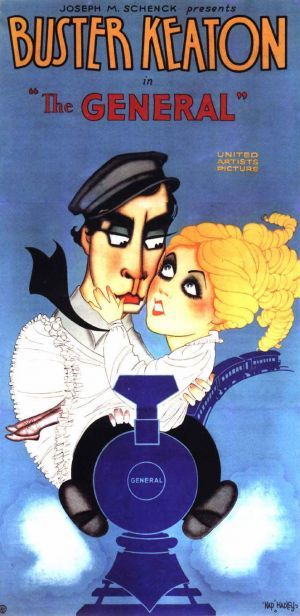
The father and son both pledge their allegiance to the South and declare that they will be enlisting. Keaton’s character responds with his famous deadpan cold stare. Then he springs into action, taking a shortcut to be the first man in line to enlist. Unbeknownst to him, he is rejected because he is too important as an engineer. Gray thinks that has been rejected due to his size. But after seeing a man of similar stature, he attempts to sneak his way back into line. After several attempts, Gray is kicked out of the station. Dejected, he starts to walk home. Annabelle’s father and brother were disgusted, thinking that he had never even attempted to get in line. When Gray tells Annabelle that they didn’t let him enlist, she doesn’t believe him. She tells him that she won’t take him back until he is in uniform.
A year later, Union soldiers make plans to cross enemy lines dressed as civilians and steal a train, burning bridges as they cross them. Cut to Annabelle getting ready to board The General to visit her ailing father. Gray is the engineer for the train that she is riding. At a stop to get some food, the Union soldiers hijack the train while Gray and the passengers are off of the train. Annabelle, on the other hand, happened to be looking for something in her luggage when the train is stolen, so she is taken with it. In the pursuing chase, the character of Johnnie Gray converts into Buster Keaton. That is because this is when the audience is no longer watching a character chase after the two loves of his life, but a Hollywood icon performing dangerous stunts for the sake of comedy.
The climax of the film results in the North and the South colliding in battle. It is here that one can see the most expensive shot in the history of silent films. To achieve the shot, Keaton took a real train and drove it over a collapsing bridge into a riverbed. The crash wreckage stayed there until it was salvaged for metal during World War II.
This movie was a failure both critically in the box office. It was due to the film’s poor showing that Keaton was forced into a limiting deal with MGM, losing his independence as a director. At the time, audiences didn’t appreciate the film’s mixture of action, drama and comedy. In fact, Keaton even tried to use the authentic locomotive for filming, but was denied because of the film’s status as a comedy. The mixture of elements was what was valued by later audiences to consider it a classic. Orson Welles said the The General was, “The greatest Civil War film ever made, and perhaps the greatest film ever made.”

No comments:
Post a Comment